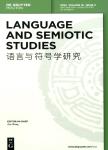A Statistical Approach to Annotation in the English Translation of Chinese Classics:A Case Study of the Four English Versions of Fushengliuji
A Statistical Approach to Annotation in the English Translation of Chinese Classics:A Case Study of the Four English Versions of Fushengliuji作者机构:Suzhou Vocational UniversityChina the School of Foreign LanguagesSoochow UniversityChina
出 版 物:《Language and Semiotic Studies》 (语言与符号学研究(英文))
年 卷 期:2020年第6卷第2期
页 面:122-144页
学科分类:0501[文学-中国语言文学] 0502[文学-外国语言文学] 050201[文学-英语语言文学] 05[文学] 050101[文学-文艺学]
基 金:sponsored by the“Overseas Reception of Suzhou Local Culture”fund(No.2019SJA1330) the Jiangsu Social Sciences and Humanities Fund(No.18WWD005)
主 题:Fushengliuji annotation statistics English translation of Chinese classics translation strategy
摘 要:Annotation in translation is of great value in communicatingthe localto the global *** on our content and function-centered statistics on the 483 notes of the four English versions of Shen Fu’s autobiographical work Fushengliuji,we find that 1)in terms of content,cultural,geographic,historical,and literary references are the most important categories of annotation in the English translation of this work;annotations in the four versions are employed to serve 6 major functions/purposes:to further inform,to facilitate understanding,to avoid misunderstanding,to interpret personally,to cite or allude,and to correct mistakes;2)no correlation can be established between the use of annotation and the reception of the work per se,but it can reflect the translator’s poise and strategy which ultimately affect the reception of the work;and 3)Lin’s version used relatively few notes and relied heavily on paraphrasing,a practice which leads to better accessibility of his translation and at the same time to the possible sacrifice of some culturally and socially significant elements of the ***’s translation used notes sparingly,and she was so creative as to rearrange and edit the original text,revealing her approach of radicalreader-centeredness.Pratt and Chiang’s version and Sanders’version used a large number of notes carrying a sinological mission,revealing their respect for the original and their decision to inform and inspire their *** argue that cultural translation,whether aided by annotation or not,is predominantly an art aboutglocalismand that both author-centeredness and reader-centeredness can be reconciled,since ultimately they serve the samecommunicativepurpose.



